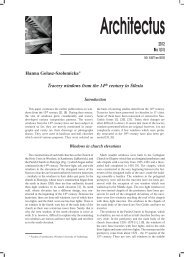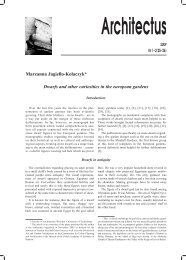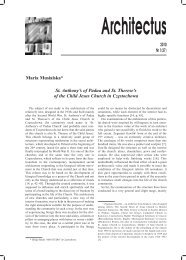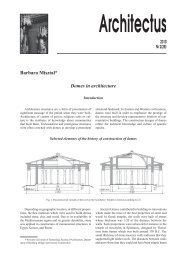Bernát Bérczi O. Cist.* The ruins and reconstruction of ... - Architectus
Bernát Bérczi O. Cist.* The ruins and reconstruction of ... - Architectus
Bernát Bérczi O. Cist.* The ruins and reconstruction of ... - Architectus
Create successful ePaper yourself
Turn your PDF publications into a flip-book with our unique Google optimized e-Paper software.
8 <strong>Bernát</strong> <strong>Bérczi</strong> O. <strong>Cist</strong>.<br />
monastery, mainly from the church in Zirc. (And they<br />
show) as I could see myself that it was not just a whatever<br />
artifact but it was really worthy <strong>of</strong> a king. But<br />
something that long-ago people once liked is not appreciated<br />
by present-day people. Though in the past it was<br />
a royal artefact, due to cruel storms, to the length <strong>of</strong><br />
time that has past <strong>and</strong> to the corrosive effect <strong>of</strong> the air,<br />
<strong>and</strong> mostly to the enemy that has set it on fire, the<br />
monastery <strong>and</strong> the church have been ruined to such an<br />
extent that they were not like a royal ornament but like<br />
a beggar’s rags.<br />
At the moment <strong>of</strong> my writing, the new monastery has<br />
already been built out <strong>of</strong> the old one <strong>and</strong> the same intention<br />
was kept in mind (this time as well), namely that the<br />
new church should be made out <strong>of</strong> the old <strong>ruins</strong>. As we can<br />
see from the previous description, the foundation-stone<br />
has been laid <strong>and</strong> the remaining <strong>ruins</strong> have been demolished<br />
one after the other. <strong>The</strong> last <strong>and</strong> most beautiful part<br />
<strong>of</strong> the façade was blasted on December 19 th this year.<br />
On this façade the window looked to be intact <strong>and</strong> very<br />
artistic but the weather has worn it very much 20. Its parts<br />
could not have been used for any other buildings.<br />
<strong>The</strong> sixth written source on the medieval Abbey <strong>of</strong><br />
Zirc can be found in the second edition <strong>of</strong> Topographia<br />
magni regni Hungariae (1750) by Father Bonbardius SJ<br />
<strong>and</strong> Father Trsztyánszki SJ. It tells us less than the<br />
description by Mátyás Bél 21.<br />
20 <strong>The</strong> text may leave us in doubt as to whether the eastern or western<br />
façade <strong>of</strong> the church was demolished last. But we see in the previous<br />
source that the western part <strong>of</strong> the church was in a bad state, or did<br />
not st<strong>and</strong> at all, <strong>and</strong> the “beautiful window” in both sources is similarly<br />
st<strong>and</strong>ing. <strong>The</strong>refore we must regard the façade holding the “very artistic<br />
window” in the description dated 1738, also based on the contents <strong>of</strong><br />
the previous source, as being “that behind the main altar”.<br />
21 P. Michael Bonbardius SJ, <strong>and</strong> P. Joannes Bapt. Trsztyánszki:<br />
Topographia magni regni Hungariae, 2. ed. Vienna, 1750. p. 140–141.<br />
Fig. 2. Detail from the bottom<br />
left part <strong>of</strong> the high altar-piece <strong>of</strong><br />
the Roman Catholic church<br />
<strong>of</strong> Olaszfalu<br />
Chronologically the last record which does not have<br />
full source value is the high altar-piece <strong>of</strong> the Roman<br />
Catholic Church <strong>of</strong> Olaszfalu 22. In the lower left corner<br />
the presumed <strong>ruins</strong> <strong>of</strong> Zirc Abbey can be seen together<br />
with two <strong>Cist</strong>ercian monks. <strong>The</strong> <strong>ruins</strong> on the high altarpiece<br />
show us a Latin cross church with basilican layout<br />
<strong>and</strong> the eastern wing <strong>of</strong> the Abbey in <strong>ruins</strong>. It completely<br />
agrees with the above mentioned account <strong>of</strong> Abraham<br />
Wabrzig concerning its building <strong>and</strong> the designed<br />
items 23. Yet, the artist used his artistic freedom: he did<br />
not make a precise plan but a painting, therefore the<br />
piers <strong>and</strong> some other items are schematic. <strong>The</strong> name <strong>of</strong><br />
the painter <strong>and</strong> the date <strong>of</strong> the painting are unknown.<br />
According to Mária Aggházy the painter may have been<br />
Bernhard Krause <strong>and</strong> the painting date from ca. 1770 24.<br />
We know that Krause has painted several pieces for<br />
Heinrichau 25. <strong>and</strong> we can find some more paintings by<br />
him in other churches founded by the Abbey <strong>of</strong> Zirc.<br />
However, Krause himself could not have seen the <strong>ruins</strong>.<br />
At his birth, in 1743 they were no longer st<strong>and</strong>ing. Presumably<br />
he might have made that portion <strong>of</strong> the painting<br />
based on some other painting or drawing, if it was<br />
painted by Krause at all 26.<br />
22 <strong>The</strong> parish established <strong>and</strong> still looked after by the <strong>Cist</strong>ercians<br />
in the neighbourhood <strong>of</strong> Zirc.<br />
23 It shows the first three bays <strong>of</strong> the sanctuary, the transept <strong>and</strong><br />
the nave to be intact. <strong>The</strong> great rose window however dimly can<br />
be discovered on the sanctuary wall. We have to note that in the picture<br />
to the left (<strong>and</strong> to the right as well?) from the sanctuary wall the<br />
dark marks <strong>of</strong> a reparation done possibly in the course <strong>of</strong> the 19 th century<br />
can be discovered.<br />
24 Mária Aggházy: A Zirci Apátság templomépítkezései a XVIII.<br />
században. Veszprém, 1937, p. 86.<br />
25 In Heinrichau, the bills paid for Krause have been found.<br />
26 It raises a question whether the “original painter” whoever<br />
he was could have seen the <strong>ruins</strong> or he painted only on the basis <strong>of</strong> narration.<br />
This latter might give an explanation for schematization.






